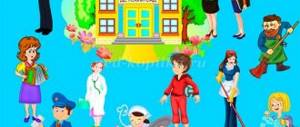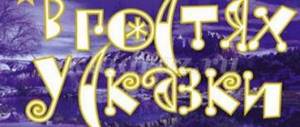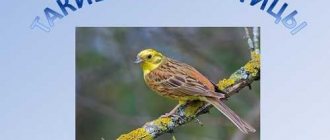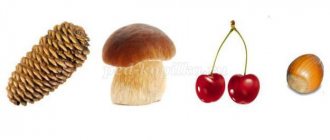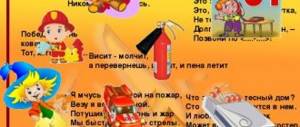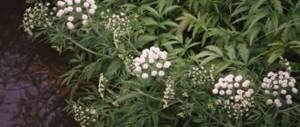Quizzes for children. Mushroom quizzes
Quiz about mushrooms, about mushrooms for schoolchildren. Create fun and exciting competitions with these quiz questions.
Quiz "Mushroom"
You went to the forest to rest,
Pick berries and mushrooms,
Take edible mushrooms,
Do not put poisonous ones in the basket.
■ Which plants do not have roots, stems and leaves? (Mushrooms).
■ What are mushroom seeds called? (Disputes).
■ What is another name for the boletus mushroom? (Porcini).
■ Which “friendly” mushrooms look like umbrellas with their thin legs and piquant yellowish caps? (Honey mushrooms).
■ Which edible mushrooms appear first? (Mols, lines).
■ Which mushrooms, with their caps, resemble beautiful pinkish puddles with running waves? (Volnushki).
■ What is the second name for the mushrooms? (Volzhanki).
■ Which mushrooms, growing in groups in pine-birch forests, have caps that look like wide pipes and are white, black or yellow? (At the milk mushrooms).
■ What are mushrooms with strong white stems and tight red or orange caps called? (Boletus).
■ Which poisonous mushrooms have caps that are not only red, but even green, gray or completely white? (At fly agarics).
■ What mushroom is called the forest hero? (Porcini mushroom, or boletus mushroom).
■ Which mushrooms growing in coniferous forests have funnel-shaped caps that collect water when it rains? (In saffron milk caps).
■ What poisonous mushrooms can be identified by their pale green cap that looks like an accordion underneath? (Pale toadstools).
■ Which mushrooms are called redheads because of their bright, distinctive caps? (Boletus).
■ Which mushrooms are similar to both boletuses (only with brownish or gray caps) and boletus mushrooms (only smaller and thinner)? (Boletus mushrooms).
■ What mushrooms used to be pickled in whole barrels and eaten with potatoes all winter? (milk mushrooms).
■ Which mushrooms have white stems and empty insides, like tubes? (At the Volnushki (Volzhanka)).
■ Which poisonous mushrooms wear a “skirt”? (Amanitas and toadstools).
■ Many mushrooms have “telling” names. Why are they called so: boletus, boletus, boletus, oak, chanterelle, russula?
Blitz quiz “Mushrooms”
■ Who wears a hat on their foot? (Mushroom).
■ Some mushrooms are edible, and some are... (Inedible).
■ The most beautiful poisonous mushrooms. (Fly agarics).
■ The most nutritious mushrooms. (Porcini mushrooms, or boletus mushrooms).
■ Mushrooms that have a special reddish-olive color. (Saffron milk caps).
■ Neighbors of birch trees. (Boletus mushrooms).
■ They most often grow under aspen trees, but are found under birch and oak trees. (Boletus).
■ Deadly poisonous mushrooms, “relatives” of the fly agaric. (Pale toadstools).
■ Most suitable for pickling. (milk mushrooms).
■ Pink mushroom, good for pickling. (Volnushka).
■ The second name for the mushrooms. Volzhanki. “They will quickly save you from starvation in the forest. (Russula).
■ Edible mushrooms that are grown all year round. (Champignon).
Similar articles:
Quizzes for children. Quiz on the topic: Medicinal plants
Quizzes for schoolchildren with answers about nature
Quiz for children about birds with answers
Quizzes for children. Animal quizzes
Quiz summary for children, grade 1
Thematic lesson: Mushrooms
After all our games with mushrooms, you probably already realized that I also couldn’t ignore thematic tasks about mushrooms and prepared them for you. I would also like to draw your attention to something new in the materials posted on all topics “Thematic Lessons”. Now I won’t post how Dima and I play with this or that set - this saves my time and effort, and our classes won’t look like a freeze frame. (This does not apply to our practice Mondays, because it is easier to show than to tell). And in the free time, I can prepare even more interesting materials for you!
And one more joy for mothers - materials will now be in such abundance that you can easily divide them into different ages from 1.5 to 6 years , i.e. you will receive a set of games on this topic not for one year, but immediately for several years!
Many types of tasks are already familiar to you and do not need a detailed description. Such repetition is useful for children, as they unobtrusively practice certain concepts in different forms. And it will be easier for you to understand what needs to be done with this or that benefit. On the blog pages I will list what is included in the kit on this topic, with a short description of why certain tasks are needed and post a link to them. There will also be a detailed description with pictures in the downloadable materials. If you have any questions, I am always ready to answer them.
Lay out a letter and a mushroom - a unique introduction to letters for kids. This is the letter G - the word Mushroom begins with this letter. You can lay it out with buttons or pebbles (sold in pet stores for aquariums).
Lay out the word mushrooms - learning to write - the child lays out a word from individual letters according to the pattern. A similar, but more complicated task is to lay out the names of mushrooms - learning to write - the child lays out words from individual letters according to the pattern.
Complete the drawing - two sheets of tasks - in one to complete the stems of the mushrooms, in the other the caps. Preparing your hand for writing.
Labyrinth - who grows where - Give the children labyrinths and markers - we conduct them and find out under which tree, which mushroom grows. Maze - walk through porcini mushrooms - The child uses a felt-tip pen to trace the path, walking only through porcini mushrooms. Preparing your hand for writing, logic and familiarity with specific mushrooms.
Memory "mushrooms" - All children can play. Print the cards in duplicate. Lay them out in front of the children, ask them to memorize them, then turn all the cards face down. Children must look for identical pairs.
Find the extra – for kids, cut the tasks into separate strips and ask them to find what’s extra in each. Explain your choice if possible. For older children, you can simply offer the whole sheet of paper; their eyes will not run away from the options.
Find the same one - game with clothespins. Offer to find among the three small mushrooms on the cards the same as the big one. And mark the correct answer with a clothespin. Finger motor skills training and development of logical thinking.
Circle the model - development of logic and attentiveness. Use a pencil to trace the mushrooms according to the pattern on the page. Give everyone their own copy.
Fold the halves - cut into separate cards and cut along a wavy line. Invite the children to find halves of mushrooms. This is an entry-level puzzle exercise. Put the puzzles together - cut them into individual cards and cut along wavy lines. Invite the children to put together pictures of mushrooms. (If you have already printed out “fold the halves”, then in a year you can simply cut the same pictures).
Finger gymnastics - Perform the indicated movements of the handles according to the diagram while reading the poem. There are two types of them for babies and older children - different options.
Swipe – kids can be asked to simply run their finger from the mushrooms to the basket. For children who can hold a felt-tip pen in their hands, draw with a felt-tip pen. Wires – connect the mushrooms to the basket. Use felt-tip pens or soft pencils. Watch how children hold a pencil. Preparing your hand for writing.
Arrange according to size and cut out mushrooms. Invite children to lay out from large to small OR from small to large. Sort mushrooms by size - Now let's find large, medium and small mushrooms. Distribute tables and cut cards “Sort by size”.
Color the russulas – Russulas are mushrooms that come in different colors. Color them in the indicated colors. We repeat colors, learn to paint carefully, and prepare our hands for writing.
Add numbers from 1 to 5 from strips - introduction to mathematics - adding a picture - the child remembers the order of the numbers. Fold the stripes from 1 to 10 and from 11 to 20 - a mathematical task - by adding the picture - the child remembers the order of the numbers. Use parts 11 to 20 if children are well developed.
Connect in order - we repeat the ordinal count - connect the mushrooms from 1 to 10 with a pencil. If the children are well prepared, then you can do the second sheet from 11 to 20. Connect - connect the mushroom and its shadow - training your hand for writing and developing logic.
Count and color - the picture shows silhouettes of mushrooms, you need to count how many there are and color the same number of circles. Attention task. Count and connect - count the dots on the fly agaric and connect with the correct number indicating this quantity. Mathematical task and hand preparation for writing.
“Count” cards - Distribute cards to children and ask them to count how many mushrooms are on the cards - mark the correct answers with a clothespin. Select cards in accordance with the preparation of children - to what number they can count. Counting and finger work.
The structure of a mushroom is a task for reading children. A card with a mushroom and separately small cards with the names of its parts. Children must put names on those parts of the mushroom that the arrow shows. You can first discuss what, where and how it is called, and then give the material as independent work to consolidate - lay out the names. There are clue letters in the picture.
Game “Mushrooms” - We listen to poems, answer questions and show how to collect mushrooms.
— Did you walk along the path? — We walked along — and did you find mushrooms? - Found. - One - honey fungus. Two - oil can. Three - wave At the edge. And four is a mushroom. Don't forget to take it. There is russula and saffron milk cap. How much will? - Five and six. _ Here we come to the clearing. The fly agaric and toadstool are here. Maybe we can take them too and put them in a basket?
Creative task - draw white dots on a fly agaric. It is more convenient for kids to draw with a finger or a cotton swab. You can also use the Creative task “Honey Mushrooms” - from the “Autumn Masterpieces” set.
You might be interested in:
Thematic lesson: The fifth day of creation part 2
Autumn finds
Lacing Leaves
Quiz. Mushroom Expert: Edible vs Inedible
You have a good understanding of mushrooms, but most likely, you only know those that are often on store shelves and, accordingly, on your table. If you like to pick mushrooms in the forest yourself, then you should learn more about them, because it is very easy to confuse a real and a false mushroom. We hope our test helped you a little to learn more about them.
These mushrooms, when they are young, have an almost white cap, then it turns a little yellow, and when mature it becomes yellow-brown or chestnut. The leg is dense, with a network of white veins. At the break, the mushroom is white.
Your answer Poisonous is incorrect
The correct answer is Edible
The cap of this mushroom is slimy and oily; it is easily separated from the stem. In young mushrooms, the edges of the cap are connected to the stem by a white film, which breaks as the mushroom grows, forming a ring around the stem. The stem is short, and the flesh of the mushroom is light yellow.
Your answer Edible is correct
The cap of this mushroom is light brown in color; on young mushrooms it is white underneath, and on mature mushrooms it is dirty gray. The leg is thin, white or gray with narrow scales. The flesh of the mushroom is white and dense.
Your answer Poisonous is incorrect
The correct answer is Edible
The cap of this mushroom is orange-red in color, and brownish-red when mature. The lower part of the cap of young mushrooms is white, while that of mature ones is greenish-gray. The flesh of the mushroom is dense, white, and when broken, first turns blue, then turns black.
Your answer Edible is correct
The young mushroom has a bell-shaped cap, and then becomes flat, its color is white, sometimes has a yellowish or greenish tint. The leg is thickened below and has rings at the top.
Your answer Poisonous is correct
This mushroom has a funnel-shaped cap with dark circles on it, and the edges are curled and pink. The leg is pink, short. The pulp is white, brittle.
Your answer Poisonous is incorrect
Correct answer: Conditionally edible
This mushroom has a funnel-shaped fleshy cap with steeply curled edges, white or greenish-white in color. The leg is thick, short, white. The pulp is white and secretes milky juice.
Your answer Conditionally edible is correct
It is difficult not to recognize this mushroom by its bright red or orange cap with white spots. The leg is white with a ring. The pulp is white, sometimes yellowish.
Your answer Poisonous is correct
This mushroom has a bright yellow or yellow-orange color. The cap of a young mushroom is almost flat, while that of a mature one is funnel-shaped. The plates pass into a short stalk. The pulp is dense, yellow.
Your answer Edible is correct
The cap is convex, ocher or brown, with small scales. In young mushrooms, the cap is connected to the stem by a thin film; in mature ones, it breaks and remains on the stem in the form of a white ring. The leg is long and thin. The pulp is yellowish.
Your answer Edible is correct
This mushroom has a cap, covered on top with an easily detachable film of green, yellow or pink color. The flesh is white, the stem is short and smooth.
Your answer Edible is correct
The stem of this mushroom in the upper part has a pattern similar to a black mesh, the tubes at the ends are pink, and the flesh turns red when broken. The hat is brown.
Your answer Edible is incorrect
The correct answer is Poisonous
The cap of this mushroom is brown, with many convolutions, similar to a walnut fruit. The leg is wrinkled, irregular in shape, hollow inside.
Your answer Poisonous is correct
Underground mushrooms grow at a depth of 10-20 cm. There are white and black. The body is tuberous, fleshy. White species on the cut are also white, and the cut on the dark ones gradually darkens, becoming violet-black with white veins.
Your answer Poisonous is incorrect
The correct answer is Edible
Reply I will not answer
Entertainment scenario for children of senior preschool age “Mushroom Quiz”
«Mushroom quiz»
Goal: expand the child’s horizons and enrich the vocabulary on the topic “ Mushrooms ”, activate children’s attention, memory and speech. Maintain an interest in wildlife. Create a positive emotional mood.
Materials and equipment: emblems for participants, magnetic board, pictures of mushrooms , toy mushrooms , baskets.
Preliminary work: conversations about mushrooms , study of proverbs and sayings about mushrooms .
Progress:
Greetings from the teams.
Educator: Good afternoon, dear children and distinguished guests. We are glad to see you at a very unusual lesson . Today two teams “Hedgehogs” and “Hares” will compete, let’s support them and greet them with applause.
competition "Warm-up"
Educator: Now I will ask each team questions, each correct answer is one point. If the team gives the wrong answer, then the opponents can answer this question. Guys, listen carefully.
1. What mushroom is called the “Colonel”? (white)
2. What mushrooms do they say “they are friendly guys”? (honey mushrooms)
3. Who is treated with fly agarics?
4. Where does the moss mushroom ?
5. What do saffron milk caps and chanterelles have in common?
6. What do honey mushrooms and milk mushrooms have in common?
7. Which mushroom a cap that feels oily to the touch?
8. Which mushroom looks like a bun ball?
9. What mushroom is called “forest death”?
10. What poisonous mushrooms do you know ?
Didactic game "Fourth odd"
Educator: Guys, in the next task you need to identify the extra word and explain why it is extra:
Boletus, strawberries, russula, saffron milk cap.
Milk mushroom, blueberry, boletus, pine.
Butterfly, honey fungus, boletus, fly agaric.
Champignon, toadstool, fly agaric, false honey fungus.
Well done, you have completed this task.
competition "Who will collect the most mushrooms"
Educator: Guys, I invite you to the mushroom meadow , where we will continue to compete. (players, while listening to music, blindfolded, take turns collecting mushrooms , stop at the “Stop” signal, the one with the most mushrooms )
Captains' competition “Do you know mushrooms?”
(on a magnetic board there are 6 pictures depicting mushrooms . The captains take one picture at a time and say the name of the mushroom , describe its appearance, features, place of growth)
Game Cut pictures.
Children are asked to collect a picture of a mushroom for a while. Two children are participating.
At the teacher’s signal, you need to collect the picture as quickly as possible. After the game, everyone writes a short description of the mushroom that appears in the picture.
Guess the riddle - show the answer King of mushrooms on a thick stem - The best for the basket. He holds his head boldly, Because he is a mushroom... (white) In the forest under a tree there is a baby, Just a hat and a leg. (Mushroom) A grass cap stood up. There is no head under the hat. (Mushroom) Under the pine tree at the edge of the forest, the red tops warm. Two cunning braids are hidden in the fragrant moss... (chanterelles). Inseparable sisters - Reddish... (chanterelles) are coming out to freedom. As if lubricated with oil, We shine in the red sun. Like forest preschool children, they grow under the pine tree... (boletus). He timidly looked out from a moss hummock, lifting a chain of ripe cranberries above his head. (Moss fly) He stood in the forest. Nobody took it. In a fashionable red hat, good for nowhere. (Fly agaric) The leg is white, straight, the hat is so red, and on the hat, on the top there are little white hemp. (Fly agaric) What kind of guys are on the tree stumps, huddled together in a tight group? And holding umbrellas in their hands, Caught by a cloud? (Honey mushrooms) The first sign of summer: Under a birch tree in the chill A brown mushroom On a spotted root. (Birch boletus) He will be born in an aspen forest, No matter how he hides in the grass, We will still find him: He is wearing a red hat. (Boletus) I was born on a rainy day under a young aspen tree. Round, smooth, beautiful, With a thick and straight leg. (Boletus) After the rain, the girlfriends settled at the edge of the forest. Multi-colored hats are the most noticeable. (Russula) Who wears a hat on his foot? (Mushroom) Who will be born with a hat? (Mushroom) Edible - inedible Scatter “mushrooms” (made of cardboard) in a forest clearing. Players collect “mushrooms” in baskets.
The task is to collect as many edible mushrooms as possible without touching the inedible ones.
Educational quiz with answers for 4th grade on the topic: Mushrooms
Educational quiz “All about mushrooms” for 4th grade students
Author: Bestik Irina Viktorovna, teacher of the Regional Special (Correctional) Boarding School for Children with Hearing Impairments, KSU, Republic of Kazakhstan, North Kazakhstan Region, Petropavlovsk. Description: an educational quiz about mushrooms in the form of a test will be useful for teachers working at the primary level, for conducting a quiz or Olympiad on environmental education for primary schoolchildren, expanding children’s horizons about the kingdom of mushrooms. Students must answer the given test questions, selecting one correct answer for each question. Goal: conducting an educational quiz in the form of a test on the topic: “Mushrooms”. Objectives: - expand children's horizons about the diverse and interesting kingdom of mushrooms, - introduce students to amazing facts about mushrooms;
- instill interest and respect for nature; — develop logical thinking, cognitive abilities and memory of students. Educational quiz “All about mushrooms” (for 4th grade students)
1. When did the main modern groups of mushrooms appear? A) 200 million years ago; B) 100 million years ago; B) 50 million years ago; D) 500 million years ago.
2. In what century did scientists define fungi as a separate kingdom, excluding them from the animal kingdom and the plant kingdom? A) in the 20th century; B) in the 19th century; B) in the 21st century; D) in the 17th century.
3. What are all types of mushrooms divided into based on nutritional and taste qualities? A) into types; B) into sections; B) to ranks; D) into categories.
4. What % of water does each mushroom contain? A) 50%; B) 90%; IN 20%; D) 100%.
5. In which country does the slime mold live, which can “walk” at a speed of 0.4 mm per second? But in Russia; B) in Germany; B) in China; D) in Australia.
6. What mushroom tincture did the ancient Vikings drink before battle in order to fly into a rage and not feel pain? A) from tinder fungi; B) from pepper mushrooms; B) from fly agarics; D) from champignons.
7. What edible mushrooms, of which there are a lot of which grow in the forests of Switzerland, no one collects? A) porcini mushrooms; B) chanterelles; B) boletus; D) oak trees.
8. Where can you most often find boletus? A) in a young forest; B) next to the anthill; B) on marsh hummocks; D) among ferns.
9. What mushrooms are considered edible mushrooms in Russia, and poisonous mushrooms in Germany? A) motley moth fly; B) real saffron milk cap; B) Polish mushroom; D) pink waves.
10. What are the only milk mushrooms that can be eaten raw? A) saffron milk caps; B) boletus; B) milkweeds; D) waves.
11. What insects in the tropics specifically grow mushrooms for their food? A) crickets; B) ants; B) stick insects; D) caterpillars.
12. What important vitamin for the body can mushrooms produce, just like humans? A) vitamin B; B) vitamin D; B) vitamin A; D) vitamin C.
13. What mushrooms are considered a delicacy in Italy? A) honey mushrooms; B) boletus; B) raincoats; D) russula.
14. What mushroom is the most dangerous and poisonous in the world? A) pale grebe; B) fly agaric; B) false chanterelle; D) serushka.
15. What is the most expensive mushroom in the world, the best varieties of which sell for 2.5 thousand dollars per 1 kg? A) value; B) saffron milk cap; B) champignon; D) truffle.
16. Which representative of the mushroom world is included in the Guinness Book as the record holder for the fastest growth rate? A) red flywheel; B) common veselka; B) collibia; D) yellow wave.
17. What substance do mushrooms contain, thanks to which they are nicknamed “meat for vegetarians”? A) glutamate; B) free amino acids; B) ribonucleotides; D) all of the above.
18. In which American state was the largest mushroom found in 1985, weighing 140 kilograms and spanning almost two meters? A) Wisconsin; B) Louisiana; B) Minnesota; D) Utah.
19. In which country are wild mushrooms practically not collected? A) in Romania; B) in Japan; B) in Poland; D) in Canada.
20. What benefits do mushrooms bring in nature? A) return nutrients to the ecosystem; B) a healthy food product for animals and people; C) help plants survive; D) all of the above.
We recommend watching:
Lifestyle quiz game for grade 4 Quiz game with answers for children in grades 3 - 4 Literary quiz with answers for grades 3 - 4 Educational quiz with answers for grade 4 on the topic: Snakes
Similar articles:
Russian language quiz game “Lucky Chance”, 4th grade
Quiz with answers “Creativity of Uspensky”, 4th grade
Game "Field of Miracles" in 4th grade. Inventions
Intellectual quiz with answers for grades 4-5
Game Lucky Chance, 4th grade
